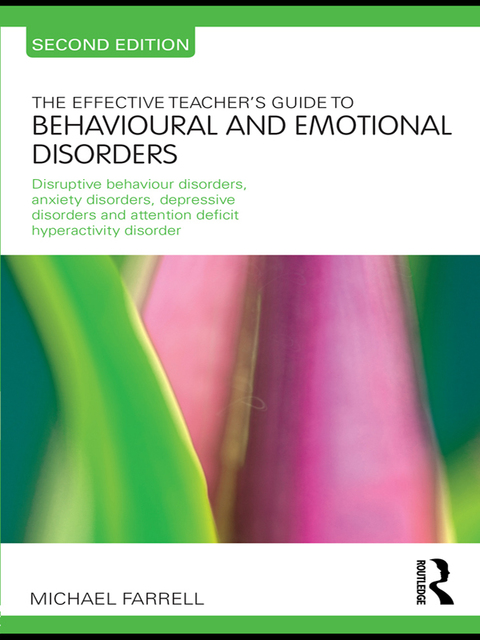Description
Efnisyfirlit
- The Effective Teacher’s Guides series, all by Michael Farrell
- Contents
- About the author
- Preface
- Chapter 1 What are emotional and behavioural disorders? Introduction
- ‘The Effective Teacher’s Guides’ Series
- The new edition
- Types of disability and disorder and types of emotional and behavioural difficulties
- Proposed readers
- Outline of the remaining chapters
- Chapter 2: Pedagogy
- Chapter 3: Key perspectives
- Chapter 4: Disruptive behaviour disorders
- Chapter 5: Anxiety disorders and depressive disorders
- Chapter 6: Attention deficit hyperactivity disorder
- Chapter 7: Conclusion
- Key texts
- Chapter 2 Pedagogy
- Introduction
- Behavioural approaches
- Learning by trial and accidental success
- Classical conditioning
- Conditioned emotional responses
- Operant conditioning
- Operant conditioning, reinforcement and discrimination
- Positive reinforcement, negative reinforcement, and punishment
- Other aspects of reinforcement
- Evaluation of behavioural approaches
- Observational learning and modelling
- Social learning theory and social cognitive theory
- Processes in observational learning and modelling
- Evaluation of social cognitive theory
- Learning theory and observational learning and emotional and behavioural disorders
- Learning theory
- Observational learning
- Elective mutism, phobia, and attention deficit hyperactivity disorder
- Elective mutism
- Phobias
- Attention deficit hyperactivity disorder
- Conclusion
- Thinking points
- Key texts
- Chapter 3 Key perspectives
- Introduction
- Psychotherapy and special education
- Three approaches
- Systems approach
- Functional family therapy
- Family and school as systems
- A joint systems approach involving family and school
- Systems perspectives and special education
- Psychodynamic approach
- Psychodynamic approaches: Klein, Winnicott and Bowlby
- Focal psychodynamic psychotherapy
- Arts therapies and play therapy
- Psychodynamic perspectives in education
- Cognitive-behavioural approach
- Cognitive and behavioural elements
- Cognitive-behavioural interventions
- Rational-emotive behavioural therapy
- Cognitive therapy
- Problem-solving dialogues and training
- Cognitive-behavioural perspectives and special education
- Conclusion
- Thinking points
- Key texts
- Chapter 4 Disruptive behaviour disorders
- Introduction
- Support for teachers and others
- Definitions, prevalence and possible causal factors
- Disruptive behaviour disorders and schools
- Oppositional defiant disorder
- Conduct disorder
- Definitions and features
- MAIN FEATURES AND CHARACTERISTIC BEHAVIOURS
- CHILDHOOD AND ADOLESCENT ONSET
- OTHER FEATURES
- LEVELS OF SERIOUSNESS, PERSISTENCE AND GENDER DIFFERENCES
- Prevalence
- Causal factors
- Identification and assessment of disruptive behaviour disorders
- Provision for disruptive behaviour disorders
- Children (3 to 10 years old)
- Parent training
- Social skills training and anger management training
- Problem-solving skills training and cognitive-behavioural therapy
- Classroom contingency management
- Adolescents (10 to 17 years)
- Family-based interventions: Functional family therapy and multi-systemic therapy
- The Teaching-Family Model in group homes, and fostering
- Combination packages of adolescent-focused interventions
- School-based interventions
- Medication
- Curriculum and assessment, pedagogy, resources, therapy and care, and organisation
- Curriculum and assessment
- Pedagogy
- Resources
- Therapy and care
- Organisation
- Other aspects of provision
- Conclusion
- Thinking points
- Key texts
- Chapter 5 Anxiety disorders and depressive disorders
- Introduction
- Anxiety disorders
- Generalised anxiety disorder
- Definition
- Prevalence
- Causal factors
- Identification and assessment
- Provision
- Obsessive-compulsive disorder
- Definition
- Prevalence
- Causal factors
- Identification and assessment
- Provision
- Phobias: Specific and social
- Definition
- Prevalence
- Causal factors
- Identification and assessment
- Provision
- Separation anxiety disorder
- Definition
- Prevalence
- Causal factors
- Identification and assessment
- Provision
- Selective mutism (elective mutism)
- Definition
- Prevalence
- Causal factors
- Identification and assessment
- Provision
- Depressive disorders
- Definitions and other matters
- Prevalence
- Causal factors
- Identification and assessment
- Provision
- Curriculum, pedagogy, resources, therapy and organisation for anxiety/ depressive disorders
- Curriculum
- Pedagogy
- Resources
- Therapy
- Organisation
- Other aspects
- Thinking points
- Key texts
- General
- For anxiety
- For depression
- Chapter 6 Attention deficit hyperactivity disorder
- Introduction
- Some debates concerning ADHD
- Shifting responsibility
- Family location within society and socialisation
- Cultural influences and pressures
- Over zealous medicalisation
- Incompatibility between child and environment
- Preferred diagnosis when ADHD co-occurs with other conditions
- Possible further developments
- Definitions
- Prevalence and co-occurrence with other disorders
- Causal factors
- Identification and assessment
- Provision
- Curriculum and assessment
- Pedagogy
- Concrete experience and active, experiential learning
- Behaviour management training
- Biofeedback
- Social skills teaching and developing compensatory skills
- Better pupil participation
- Resources
- Therapy/care
- Organisation
- Breaks and structure
- Classroom layout
- Routines, sequences and duration
- Criticisms of organisation involving separation and structure
- Other provision
- Parent training and support
- Diet
- Thinking points
- Key texts
- Internet
- Chapter 7 Summary and conclusion
- Emotional and behavioural disorders and areas of provision
- Pedagogy and approaches
- Provision for particular disorders
- Disruptive behaviour disorders
- Anxiety disorders
- Depressive disorders
- Curriculum, pedagogy, resources, and organisation for pupils with anxiety disorder and depressive disorders
- Attention deficit hyperactivity disorder
- Curriculum and assessment, pedagogy, resources, therapy/ care, organisation and other provision
- A final word
- Bibliography
- Index






Reviews
There are no reviews yet.